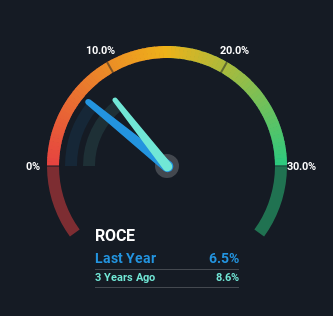- Australia
- /
- Hospitality
- /
- ASX:CKF
Some Investors May Be Worried About Collins Foods' (ASX:CKF) Returns On Capital
If you're looking for a multi-bagger, there's a few things to keep an eye out for. Ideally, a business will show two trends; firstly a growing return on capital employed (ROCE) and secondly, an increasing amount of capital employed. Put simply, these types of businesses are compounding machines, meaning they are continually reinvesting their earnings at ever-higher rates of return. In light of that, when we looked at Collins Foods (ASX:CKF) and its ROCE trend, we weren't exactly thrilled.
Understanding Return On Capital Employed (ROCE)
For those that aren't sure what ROCE is, it measures the amount of pre-tax profits a company can generate from the capital employed in its business. Analysts use this formula to calculate it for Collins Foods:
Return on Capital Employed = Earnings Before Interest and Tax (EBIT) ÷ (Total Assets - Current Liabilities)
0.065 = AU$79m ÷ (AU$1.4b - AU$181m) (Based on the trailing twelve months to October 2023).
So, Collins Foods has an ROCE of 6.5%. On its own that's a low return on capital but it's in line with the industry's average returns of 7.3%.
View our latest analysis for Collins Foods

In the above chart we have measured Collins Foods' prior ROCE against its prior performance, but the future is arguably more important. If you'd like to see what analysts are forecasting going forward, you should check out our free analyst report for Collins Foods .
What Can We Tell From Collins Foods' ROCE Trend?
In terms of Collins Foods' historical ROCE movements, the trend isn't fantastic. To be more specific, ROCE has fallen from 11% over the last five years. Although, given both revenue and the amount of assets employed in the business have increased, it could suggest the company is investing in growth, and the extra capital has led to a short-term reduction in ROCE. And if the increased capital generates additional returns, the business, and thus shareholders, will benefit in the long run.
The Bottom Line On Collins Foods' ROCE
Even though returns on capital have fallen in the short term, we find it promising that revenue and capital employed have both increased for Collins Foods. And the stock has followed suit returning a meaningful 79% to shareholders over the last five years. So while investors seem to be recognizing these promising trends, we would look further into this stock to make sure the other metrics justify the positive view.
One more thing: We've identified 2 warning signs with Collins Foods (at least 1 which makes us a bit uncomfortable) , and understanding them would certainly be useful.
While Collins Foods isn't earning the highest return, check out this free list of companies that are earning high returns on equity with solid balance sheets.
New: AI Stock Screener & Alerts
Our new AI Stock Screener scans the market every day to uncover opportunities.
• Dividend Powerhouses (3%+ Yield)
• Undervalued Small Caps with Insider Buying
• High growth Tech and AI Companies
Or build your own from over 50 metrics.
Have feedback on this article? Concerned about the content? Get in touch with us directly. Alternatively, email editorial-team (at) simplywallst.com.
This article by Simply Wall St is general in nature. We provide commentary based on historical data and analyst forecasts only using an unbiased methodology and our articles are not intended to be financial advice. It does not constitute a recommendation to buy or sell any stock, and does not take account of your objectives, or your financial situation. We aim to bring you long-term focused analysis driven by fundamental data. Note that our analysis may not factor in the latest price-sensitive company announcements or qualitative material. Simply Wall St has no position in any stocks mentioned.
About ASX:CKF
Collins Foods
Engages in the operation, management, and administration of restaurants in Australia and Europe.
Reasonable growth potential with mediocre balance sheet.
Market Insights
Community Narratives




